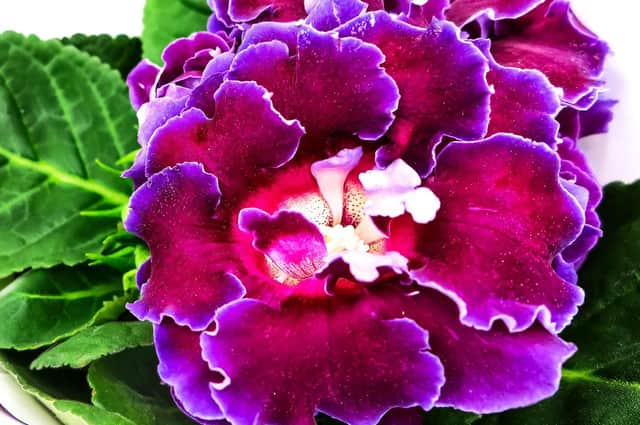GARDENING: Glorious gloxinias make wonderful house plants


It's a pity more people don't grow them because they are a very good house plant, the leaves are thick, beautifully veined and the gorgeous trumpet flowers are available in lots of different colours.
All the plants need is a well-drained compost, not too much water, plenty of light near a window but not in direct sun.
Advertisement
Hide AdAdvertisement
Hide AdIf you would like to grow some, they are normally in stock at garden centres as potted plants from April onwards, and they normally only have one or two blooms on each plant so it's easy to pick out your favourite colour.
You may have a gloxinia corm which you enjoyed last summer, now is the time to replace the compost to start it off again.
Gloxinias prefer a loamless compost, this is the type of compost that most people use these days, they are potted into four and a half inch diameter pots.
The top of the tuber has a shallow bowl shape whilst the base is rounded, if you are not sure which way to plant them, look at the centre of what you think is the top and you will see tiny bits of last year's stems.
Advertisement
Hide AdAdvertisement
Hide AdIn addition to this there will be short brown dead looking roots pointing downwards around the edge of the tuber.
Once the pot has been filled with compost to within half-an-inch of the top of the pot, gently press the tuber into the compost to half the depth of the tuber '“ just as we do with cyclamen tubers.
Water the compost and place the pot in a light spot out of direct sunshine and the shoots will appear within three weeks. If they don't, you have managed to plant the tuber upside down, so turn it up the other way!
If you enjoy growing plants from seeds and would like to have a go at gloxinias, this is the time too sow the seeds.
Advertisement
Hide AdAdvertisement
Hide AdThey are not difficult to germinate and there will be far too many plants for a small greenhouse, so pot up the spare plants and sell them to aid your favourite charity.
'¢ Seeds will germinate well in any seed sowing compost, essentially a seed compost, if a strong potting compost such as John Innes numbers 1, 2 or 3 are used.
Sow the seeds in the seed compost in a half-size seed tray, lightly cover the surface with vermiculite and then soak the seed tray in water to which is added Copper Mixture and leave it to soak up the solution for half-an-hour.
The best way of doing this is to use a washing up bowl, measure the water, add the Copper Mixture so that there is enough solution to go half way up the seed tray.
Advertisement
Hide AdAdvertisement
Hide AdThe Copper Mixture prevents damping off disease, that's the disease which attacks the base of the seedlings which then collapse and die. There is no cure, it has to be prevented with Copper Mixture.
The dilution rate is the same as that recommended for copper defiency on the green drum.Â
Once the seedlings are large enough to handle, each one is then potted into insert cells using the 24 cells which fit into a standard seed tray. Any loamless compost is suitable and once the cells are full of roots, each plant is potted into a 4.5in diameter pot.
After three weeks, commence feeding using a liquid tomato fertiliser fortnightly and the blooms will appear in mid August and last for many weeks.
Â
THIS WEEKS' TOP TIPS
Advertisement
Hide AdAdvertisement
Hide AdThis is the best time to buy in those lovely surfinia petunias, scaevola, ivy leafed geraniums and other gems we all enjoy growing in baskets and tubs. These plants can all be propagated by keeping them warm in a plant propagator.Â
Â
Â
Â
Â
Â
Â
Â
Â
Â
Â
Â
Â
Â
Â
Â
Â
Â
Â
Â
Â
Â
Â
Â
Â
Â
Â
Â
Â
Â
Â
Â
Â
Â
Â
Â
Â
Â
Â
Â
Â
Â